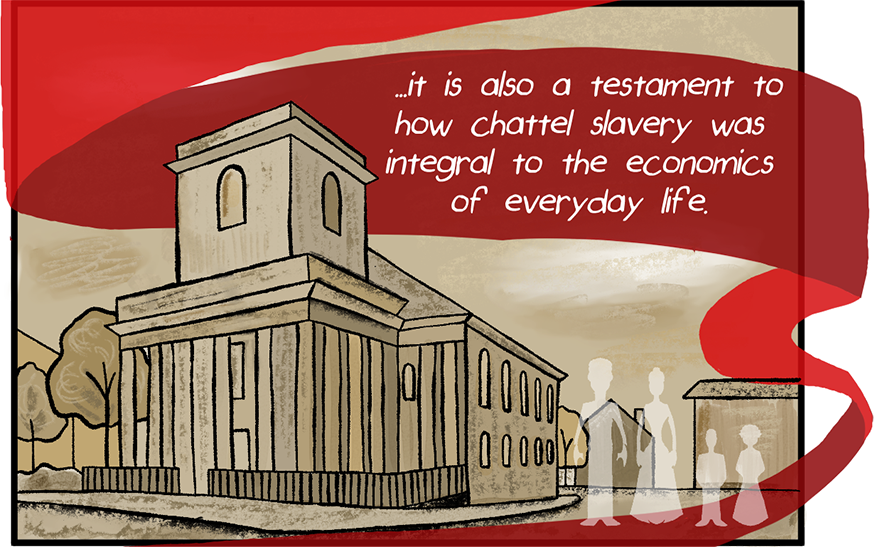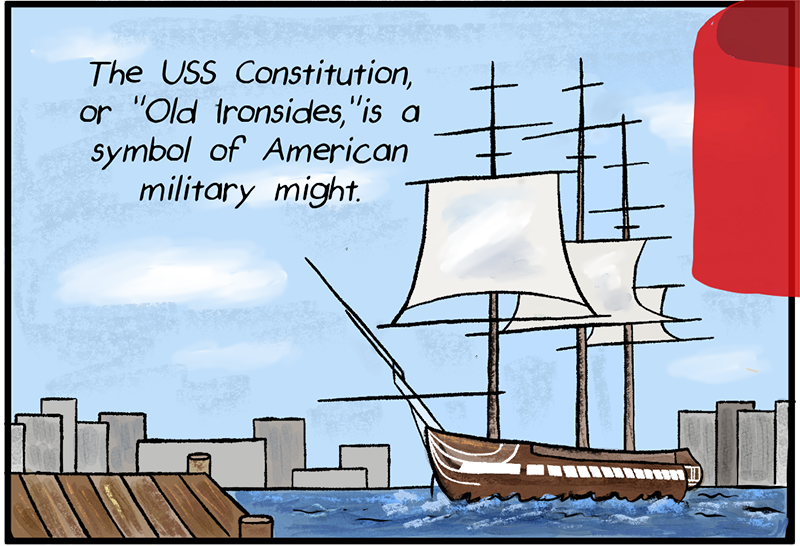
The illustrations in this article were created by students of the MFA in Visual Narrative program at BU’s College of Fine Arts and Joel Christian Gill, associate professor of art and chair of the Department of Visual Narrative.
Boston’s Hidden History of Slavery
How one journalism class helped to expose the ties between enslaved people and the city’s most famous landmarks
Cassandra Dumay toured King’s Chapel during a fifth grade field trip. James Buckser used to visit the USS Constitution with his father, an avid model boat builder. Kajsa Kedefors was drawn to Boston Common as the public center of the city when she arrived at BU from California. None of them considered the role of slavery when they visited those historic sites. Few people do.
The landmarks represent 3 of 17 sites on Boston’s Freedom Trail, a 2.5-mile route, marked with a red paint-and-brick line, that attracts approximately four million visitors each year. But the history they learn from tour guides in tricorner hats, museum curators and educational displays typically focuses on the freedom won by white colonists, and ignores the presence and contributions of enslaved people.
Representatives at several historic sites in Boston are grappling with the erasure of people of color from the city’s history, but it took a collaboration between a COM journalism class and the public radio station GBH to bring their stories to a larger audience. When the results of their months-long investigation were published online in July 2023, the reaction was immediate. The Freedom Trail Association said they planned to share the findings with their tour guides. Schools approached Brooke Williams, who taught the class, about updating their curriculum to include the COM students’ work.
“This might have the most impact of any journalism I’ve ever done,” says Williams, an associate professor of the practice of computational journalism and a journalist who has contributed to page one investigations for the New York Times. “The system is actually changing.”
REEVALUATING HISTORY
In 2022, GBH news wrote about the connections historians had established between early members of Old North Church—another stop on the Freedom Trail—and the trade of enslaved people. “Reading about how integrated enslavement was into the entire colonial economy—it couldn’t have just been Old North Church, right?” says Paul Singer, the investigations and impact editor at GBH. He wanted to dig further, but “we didn’t have the people power.”
Singer asked Williams, whom he’d collaborated with before, if her class could help. Buckser (’25), Dumay (’25), Kedefors (CGS’21, CAS’24) and 14 other student journalists had been accepted into the spring 2023 section of Reporting in Depth, where they would form their own newsroom and report for professional news outlets. Singer’s idea became their semester-long project.

In February, the students divided up sites on the trail and fanned out across Boston to interview sources and scour archives. They paged through history books, diaries and burial records. They struggled to decode 18th-century script. And they began to piece together the sparse clues needed to tell the untold history of enslaved people at some of Boston’s most famous landmarks.
“By the second meeting of the class, there was a palpable sense of excitement in the room because people were finding stuff,” Singer says.
SIGNIFICANT BLIPS IN TIME
Buckser chose to research the USS Constitution because of his memories of visiting the ship with his family. He immersed himself in naval documents from the Barbary Wars, 19th-century conflicts in which the vessel fought. He also interviewed Carl Herzog, public historian at the USS Constitution Museum, who was able to give Buckser his big break: the US Navy used enslaved laborers in Georgia to harvest the wood used to build the ship.
“It’s all well-documented, it’s all publicly available information,” Buckser says. “It’s just that nobody cared to look for it.”
Dumay and Jessie Sage O’Leary (’24) teamed up to study King’s Chapel, which dates back to 1686. They learned that members of the chapel staff had spent the past several years doing their own research on their congregation’s past.
They found that at least 71 enslavers and 219 enslaved people had connections to the church. In fact, more than half the money used to fund the chapel’s construction came from those involved with the slave trade.
In June, the King’s Chapel congregation approved plans for a memorial honoring the 219 people. They will erect a statue outdoors of an enslaved woman opening bird cages and 219 bronze birds will be perched around the chapel and grounds. Inside, the chapel ceiling will be covered with a mural of birds in the sky. “When they described it to me, my eyes started watering because it was so beautiful,” Dumay says. “They’re definitely an example of transparency. They have a real willingness to grapple with the issue.”


Many of the student journalists found references to specific enslaved people in probate records—the documents needed to settle an estate after someone’s death—where they were often listed as property. “They only show up as mentions in someone else’s history,” says Singer. “That’s what erasure looks like.”
Kedefors had to dig a little deeper to find her story. Boston Common is America’s oldest public park, so there are no private records of assets or household members to establish the presence of enslaved people. She spent hours searching the archives at the Boston Public Library. “There was just no real mention of Black people,” she says. Eventually, Singer discovered a 1723 ordinance banning Black and Indigenous people from Boston Common after sunset. In order to be banned, they must have been present, Singer and Kedefors reasoned. “That was the story—that we couldn’t find them,” she says.
An interview with Joe Bagley (CAS’06), city archaeologist for Boston, was just as revealing. The city has never uncovered physical evidence of enslaved people in the Common, he said. But they had to be present simply because there were many enslaved people in Boston. Massachusetts had been the first state or commonwealth to legalize slavery, and Bagley’s office has estimated that 10 percent of the people in the city in the early 1700s were enslaved. “He said something that stuck in my mind,” says Kedefors. “We’re looking at blips in people’s lives when you do find a mention of them—and then they’re gone. You can’t track these people and their lives.”
IMPACT JOURNALISM
GBH published their collaboration with Williams’ class on July 19. An opening essay from Singer was accompanied by an interactive map linked to essays for each stop on the Freedom Trail. Dumay and O’Leary appeared in a video about King’s Chapel and live on the radio to talk about the project.
Reactions quickly flowed in. “A lot of people said that they thought this was an important story to tell, and it was important to tell it in one place,” says Singer. He also received a critique: a Native American activist pointed out that colonial Boston’s economy wasn’t grounded in enslavement—it was grounded in the extermination of the people who had originally inhabited the land. “He’s correct, there’s another layer to this story to write,” Singer says. The project has given journalists at GBH a new lens through which to examine stories.


Although the students of Reporting in Depth have moved on, they’re grateful for the role they played in telling this story. “It was pretty transformative,” Kedefors says. Buckser says he hopes the students’ work helps people see the Freedom Trail in a different light.
“This project came at a perfect moment, as a lot of these sites are dealing with their own history,” Dumay says. “We can’t grapple with reality as it exists now if we don’t look at where we started.”


